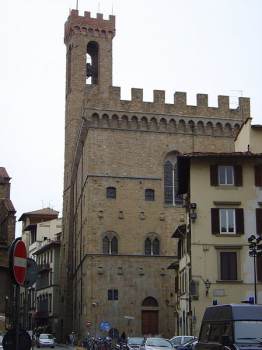|
|
| |
ITALY
FLORENCE MUSEUMS
Academy of Fine Arts The Accademia di Belle Arti is an art academy in Florence, Italy and it is now the operative branch of the still existing Accademia delle Arti del Disegno ("Academy of the Arts of Drawing") that was the first academy of drawing in Europe. The Gallery of the Accademia di Belle Arti has housed the original David by Michelangelo since 1873. The sculpture was moved from Piazza della Signoria for reasons of conservation. Today the gallery's small collection of Michelangelo's work includes his four unfinished Prisoners, intended for the tomb of Pope Julius II, and a statue of Saint Matthew, also unfinished. Among the notable renaissance works on display are an outstanding collection of 15th and 16th century Florentine paintings by Paolo Uccello, Domenico Ghirlandaio, Sandro Botticelli and Andrea del Sarto.
For more information and enquiries please contact SEDE CENTRALE, Via Ricasoli 66,
Tel.: +39055215449, E-mail: segreteria@accademia.firenze.it
 Michelangelo's David in the Accademia Gallery
Bargello The Bargello, also known as the Bargello Palace or Palazzo del Popolo (Palace of the People) is a former barracks and prison, now an art museum, in Florence, Italy. The building is designed around an open courtyard with an external staircase leading to the second floor. An open well is found in the center of the courtyard. The Bargello opened as a national museum (Museo Nazionale del Bargello) in 1865, displaying the largest Italian collection of gothic and Renaissance sculptures. The museum houses masterpieces by Michelangelo, such as his Bacchus, Pitti Tondo (or Madonna and Child), Brutus and David-Apollo. Its collection includes Donatello's David and St. George Tabernacle, Vincenzo Gemito's Pescatore ("fisherboy"), Jacopo Sansovino's Bacco, Giambologna's Architettura and his Mercurio and many works from the Della Robbia family. The museum also has a fine collection of ceramics (maiolica), textile, tapestries, ivory, silver, armours and old coins.
For more information and enquiries please contact Via del Proconsolo 4, 50122 Firenze,
Tel. +39 0552388606, E-mail: museobargello@polomuseale.firenze.it
 The Bargello
The Uffizi Galleryhe Uffizi Gallery is one of the oldest and most famous art museums of the Western world. It is housed in the Palazzo degli Uffizi, a palazzo in Florence. Over the years, further parts of the palace evolved into a display place for many of the paintings and sculpture collected by the Medici family or commissioned by them. The gallery had been open to visitors by request since the sixteenth century, and in 1765 it was officially opened to the public. Because of its huge collection, some of its works have in the past been transferred to other museums in Florence — for example, some famous statues, to the Bargello. Today, the Uffizi is one of the most popular tourist attractions of Florence. In high season (particularly in July), waiting times can be up to five hours. Visitors who reserve a ticket in advance have a substantially shorter wait.
Here is only a small selection from the world-class collection of paintings:
Leonardo da Vinci (The Annunciation, The Adoration of the Magi)
Sandro Botticelli (Primavera, The Birth of Venus, The Adoration of the Magi and others)
Michelangelo (The Doni Tondo)
Raphael (Madonna of the Goldfinch, Pope Leo X with Cardinals Giulio de' Medici and Luigi de' Rossi)
Simone Martini (The Annunciation)
Rembrandt Van Rijn (Selfportrait as a Young Man, Selfportrait as an Old Man, Portrait of an Old Man)
For more information and enquiries please contact Piazzale degli Uffizi, 50122 Firenze, Tel: +39 0552388651, E-mail: direzione.uffizi@polomuseale.firenze.it
 Hallway of the Uffizi Gallery, Florence, Italy Photo by Sailko Museo di Storia Naturale di FirenzeThe Museo di Storia Naturale di Firenze is a natural history museum in 6 major collections, located in Florence, Italy. It is part of the University of Florence.
Today's collections are as follows:
Giardino dei Semplici - Europe's third oldest botanical garden, established in 1545, now containing some 9,000 plant specimens.
Museo di Botanica - a large herbarium of approximately 4 million specimens, including the historic collections of Andrea Cesalpino (1563), claimed to be the first scientific herbarium.
Museo di Geologia e Paleontologia - About 200,000 specimens from the collections of noted geologists and paleontologists. The vertebrate fossil collection (26,000 specimens) is of particular interest, with mammal fossils from the Pliocene and Pleistocene, primarily recovered from Tuscany and Valdarno, including Oreopithecus bambolii, anthropoid primates, and early elephant skeletons. The paleobotany collection includes a further 8,000 items.
Museo di Mineralogia e Litologia - About 50,000 specimens in a number of collections. Of particular interest are the earliest items from the Tribuna degli Uffizi (about 500 specimens), and the collection of Giovanni Targioni Tozzetti (about 5,000 items), cataloged in 12 manuscript volumes.
Museo Nazionale di Antropologia ed Etnologia - About 15,000 ethnological items and 6,100 anthropological items, with a photographic collection containing a further 26,000 prints and 7,000 negatives. The original collection was a cabinet of curiosities containing items such as an ivory horn from the Kingdom of Kongo, Persian insignia of command, and bows and arrows from the upper Amazon.
Zoologia "La Specola" - A major collection of some 3 million zoological specimens, of which about 5,000 are on public display, with a further 3,000 specimens in the hall of skeletons. The collection of wax anatomical models is of particular interest. It was begun in 1771 by Grand Duke Pietro Leopoldo and is said to be the largest such collection in the world; about 1,400 models are currently on public display.
Museum collections are open mornings except Wednesday, and all day Saturday; an admission fee is charged.
For more information and enquiries please contact Via La Pira, 4, 50121 Florence, Tel. +39 055 27571, E-mail: segrmuseo@unifi.it
 Museo di Storia Naturale di Firenze Zoological wax specimens in the Zoologia "La Specola"
|
|
|
|
|